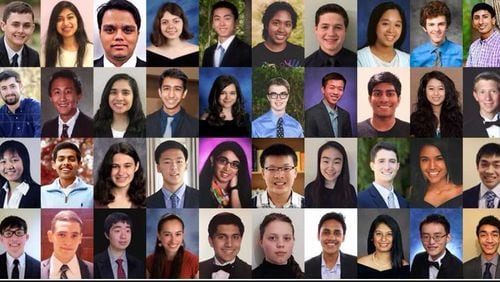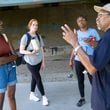A few years ago, I attended a luncheon honoring DeKalb students with the highest scores on college entrance exams. A striking number were children of immigrants from Asia and Africa.
My son is on his high school’s academic team, so I've attended several statewide tournaments with teams from across Georgia. Many of the students – who typically are in the top-tier of academic performance at their schools and bound for Georgia Tech or similar elite schools – are also immigrants or children of immigrants.
A new report from the National Foundation for American Policy notes 33 of 40 finalists in the 2016 Intel Science Talent Search were the children of immigrants. Considered the most prestigious high school science competition in the country with three top awards of $150,000, the event is organized by the Society for Science & the Public.
(This year the competition -- underway this week in Washington, D.C. -- is named after its new sponsor Regeneron Pharmaceuticals. You can read about the 2017 finalists here. There are no Georgia students among them.)
Among the findings in the National Foundation for American Policy report:
•Among the 40 finalists, 14 had parents both born in India, 11 had parents both born in China, and 7 had parents both born in the United States. To put these numbers in perspective, people of Indian and Chinese birth represent only about 1 percent of the U.S. population each, according to the Pew Research Center.
•The evidence indicates that the children of immigrants are increasing their influence on science in America. Sixty percent (24 of 40) of the finalists of the 2004 Intel Science Talent Search had at least one immigrant parent. In 2011, that proportion rose to 70 percent (28 of 40) who had at least one immigrant parent. And in 2016, the number rose again to 83 percent (33 of 40) of the finalists of the Intel Science Talent Search who had at least one immigrant parent.
•At the 2016 Intel Science Talent Search, 7 of the 9 top awards were earned by the children of immigrants, including first place prizes for innovation and basic research. Amol Punjabi won the First Place Medal of Distinction for Basic Research for developing software that could be used by pharmaceutical companies to combat cancer and heart disease. Maya Varma won the First Place Medal of Distinction for Innovation for creative problem-solving skills. Milind Jagota was awarded the Second Place Medal of Distinction for Innovation for research on "a less costly alternative to the transparent conductors now used in touchscreen devices."
•The children of immigrants among the finalists interviewed greatly appreciated the sacrifices their parents made to ensure they received the best education possible. "Seeing what my parents did to make a better life for their children has inspired me to do everything I can to succeed. This is the land of opportunity," said Augusta Uwamanzu-Nna, whose father, a physical therapist, came to America on an H-1B visa.
•More than 95 percent of winners of the Intel Science Talent Search (STS) traditionally have pursued science as a career, with 70 percent earning Ph.D.'s or M.D.'s
This week, the AJC has an excellent story about H-1B visa holders. As reporter Michael Kanell explains in this brief excerpt:
But the program has come under periodic criticism. And because it lies at the intersection of immigration and jobs, it could soon be ratcheted back as part of the Trump administration's signature efforts on those issues.
Much of the national argument has been about immigrants in American fields, factories, restaurants and construction sites. By definition, H-1B holders are legal, documented workers, likely to be in labs or staring into computer screens. Roughly one-quarter of metro Atlanta's software developers and doctors are immigrants, according to a 2015 study by the Georgia Budget and Policy Institute.
But just a fraction of those people are here temporarily holding the H-1B visa, and there are a lot more immigrants doing blue-collar work in construction, hospitality or agriculture, said Wesley Tharpe, research director at the GBPI.
About the Author







